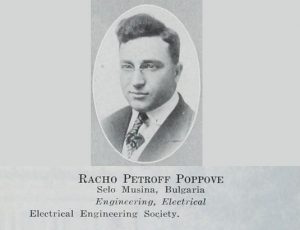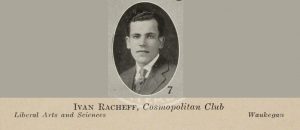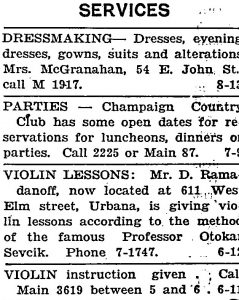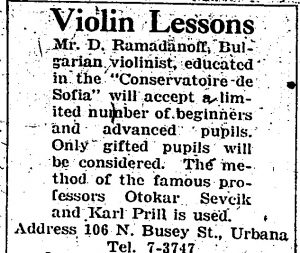Since, at least 1911, Bulgarian students have attending the University of Illinois. Some early Bulgarian Illini have included chemists, civil engineers, electrical engineers, medical doctors, metallurgists, philanthropists, philatelists, singers, soldiers, and violinists too. Read on to learn more about early Bulgarian Illini!
Early Illinois – Bulgaria Connections
As early as 1903, as a Star Course speaker, Bulgarian diplomat and scholar Stefan Panaretov (Стефан Панаретов) was invited to campus. His December 3 evening talk “Revival of the Bulgarian People” was given at the (former) University Chapel. While in town, Mr. Panaretov and his wife resided with Economics Professor and Liberal Arts and Sciences Dean David Kinley (Record Series 2/6/20) who just so happened to be principal of the North Andover, Massachusetts high school when Mrs. Panaretov was a student there.
In 1924, Mr. Panaretov was scheduled to return for two talks including “The Progress of Bulgaria Since 1878” and “The Foreign Policy of Bulgaria”. Unfortunately, citing a recent illness, the campus visit was delayed until the following spring. Fortunately, the April 1925 trip expanded to three talks. The new schedule included: April 27’s “The Development of Bulgaria Since its Political Emancipation in 1878” in 202 Lincoln Hall; April 28’s “The Foreign Policy of Bulgaria During the Last Forty Years” in 103 New Agriculture Building; and a April 29 talk on recent political developments in Bulgaria for the University Club. Following the first talk, at least one editorial from a Daily Illini writer appeared.
Students
In 1911, one of the first students to enroll, might have been Mr. Dimiter G. Fournadjieff, who completed a medical degree in Chicago in 1915, of Samokov. [1] Mr. Fournadjieff was also one of four students to receive a Rea scholarship from the School of Medicine. After graduation, Mr. Fournadjieff followed a long medical career in Michigan, New York, and Pennsylvania.
In 1912, Mr. Racho Petroff Poppove, (B.S. Electrical Engineering, 1918), of Musina, had enrolled. [2] While he was a student, Mr. Poppove was a member of the Electrical Engineering Society. After graduation, he was given “send-off” orders for World War One. While not much else is known about Mr. Poppove yet, he may have been the unidentified Bulgarian student in a May 1918 The American Magazine article about Illinois Dean of Men Thomas Arkle Clark.
In 1914, Mr. Ivan Racheff, (B.A. Liberal Arts and Sciences 1917), of Lovech, Bulgaria, came to the University of Illinois to study chemistry, preparing himself for a successful life in metallurgy. [3][4] While he was a student, Mr. Racheff was a member of Cosmopolitan Club. His travels continued, as his career took him across the country, while he kept his offices in Illinois and Tennessee. In Illinois, Mr. Racheff ran the Racheff Metallurgical Laboratory in Chicago. While in Tennessee, he developed the Knoxville Iron Company into the successful Knoxville Iron Works. By the end of his career, Mr. Racheff had planned for the Knoxville Iron Works building to become a gardens, as well as great financial gifts be provided for the University of Tennessee and University of Illinois where multiple prestigious Illinois awards, endowments, and fellowships carry his name. [5] In fact, Mr. Racheff even arranged for his metallurgical research reports to be donated to the University Library too, where they are still accessible today.
Mr. Penco Gherganoff, (B.S. Mechanical Engineering, 1918) of “Kalibeto, Troyan” (also once jokingly confused as “somewhere in Bulgaria” by another student), was active in campus life and known for his politeness. [6] In Mathematics Club, he gave a Fall 1915 talk “Proofs of the Addition Theorem in Trigonometry”. That same semester, he joined the multicultural student organization Cosmopolitan Club (Record Series 41/64/8). In 1916, with just seventy-two other students, he was given preliminary honors. In 1917, at the Junior Class smoker, he performed two Bulgarian songs. While in 1918, he sang French songs for the annual Spring Soiree for the French Club.
Mr. Vladimir Tane Belleff, (B.S. Agriculture, 1920) of “Stroumitza” (possibly “Strumica”) was active in campus life and he became a lifelone resident of local community too. During summer 1917, he cared for local yards. In Spring 1920, with J. C. Blair, Mr. Belleff supervised the planting of trees 131 through 142, for the World War veterans memorial project. In Fall 1920,
After arriving in 1917, Bogomil Georgioff, (B.A. Banking, 1925), was one of eleven Bulgarian students (of twenty in the United States) by 1921. As one of the few Bulgarian students in the U.S., Mr. Georgioff utilized his opportunity to inform other university students of contemporary Bulgaria. In fact, in a candid criticism of the Peace Conference at Versailles with a Daily Illini reporter, he said: [8]
Bulgaria cannot possibly live with her enormous debt laid down to her by the Peace Conference at Versailles […] In normal times she probably could care for this obligation but one must realize that the most valuable half of her land, which is rich in both cultured people and crops has been taken away. Our only port also went with the transfer.
However, since the war, Mr. Georgioff was optimistic about economic development in Bulgaria.
Since the war Americans have come to be acquainted with Bulgaria and consequently we are carrying on more extensive commerce with them. The greatest American commercial activity that is representative of the true conditions is found in the Standard Oil Company which is doing a very extensive business.
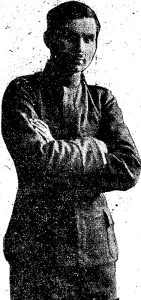
After World War One ended, some Bulgarian students arrived with few possessions and no money. After coming to New York, George John Boshkoff (B.S. Mechanical Engineering, 1923) sold his extensive stamp collection to pay for his education, the Daily Illini reported. [9] Fortunately, it was only a few years later with his Illinois engineering degree, Mr. Boshkoff returned to New York where he became an engineer (before becoming an executive) for Union Carbide Corporation. He remained on the east coast for the remainder of his career, where he later married and raised a family. [10] [11]
Also arriving in 1920, Dimiter Ramadanoff, (B.S. Electrical Engineering, 1924), would later say that he arrived in the United States, “with $50 and a violin.” [12] At Illinois, Mr. Ramadanoff put his mind and his violin to work. While in town, Mr. Ramadanoff was a popular violin performer for community events hosted by the Y.W.C.A., the Chinese Student Association, and the Philippine Student Association. [13] [14] [15] [16] Soon after, Mr. Ramadanoff was a violin tutor too. After multiple performances across campus, beginning in 1923, he offered violin lessons “according to the method of the famous Professor Otokar Ševčík”. [17] [18] In the fall of 1926, September 12 to be exact, when Mr. Ramadanoff married Urbana High School graduate Thelma A. Briggs in her parents’ home. Their wedding was the same day as their departure. After their morning wedding, they hosted a wedding breakfast for 25 guests, and they left, the same day, for Ithaca, New York to continue their studies. [19] Mrs. Ramadanoff enrolled in an undergraduate program, and Mr. Ramadanoff enrolled in a graduate program. After graduation, they settled in Ohio, where Mr. Ramadanoff was involved the decision for the Berea Water Treatment plant’s early use of ozone to treat water for filtration. As a result, the facility was later named the Dr. Dimiter Ramadanoff Water Treatment Plant.
While many Bulgarian students arrived alone, they were not alone for long. Early Daily Illini articles often include multiple Bulgarian students at different campus events together. Bulgarian students found support from faculty members like History Professor A.T. Olmstead and History Professor Albert H. Lybyer who hosted the students for holiday breaks or dinners, while other students were out of town. [20] Also, Bulgarians in the greater Champaign County community hosted students too. [21]
Bulgarian student enrollment would continue until World War Two. Following the war, student enrollment dropped and was almost nonexistent until the late 1980s. Today, Bulgarian students continue to come to the University and some have been known to form Bulgarian student clubs too.
Are you a Bulgarian Illini? Do you know someone who is? We’d like to hear from you! Please send us a message or leave a comment below. We want to include you and your story, as we celebrate the first 150 years of the University of Illinois.
Happy First 150 everyone!
(A special thank you to the 2015-2016 University of Illinois Slavic Graduate Student Association and Dr. David Cooper who gave feedback on an early version of this work.)
References
[] As always, a special thank you to all students and staff whose tireless work for student life and publications (many of which are available at the University Archives) help preserve the memories of Illini everywhere.
[1] Sometimes, he is listed as “Dimiter Fournad”. For a historical analysis of Mr. Fournadjieff’s career in the medical school, see: Reforming Medical Education: The University of Illinois College of Medicine, 1880-1920, by Winton U. Solberg, 2009. Pages 199-200.
[2] “Racho Petrov Poppove”, The Semi-Centennial Alumni Record of the University of Illinois, Edited by Franklin W. Scott, page .
[3] “Ivan Racheff”, page 692.
[4] The 2002 Ivan Racheff House application for the National Register of Historic Places includes a detailed biography of Mr. Racheff, a history of the Knoxville property. Please see the National Park Service website, to search for a digital copy: http://focus.nps.gov/ .
[5] “U. of I. Gets $5.5 Million from 1917 Grad’s Estate” by Jean Latz Griffin, Daily Illini, February 19, 1985.
[6] “Penco Gherganoff”, The Semi-Centennial Alumni Record of the University of Illinois, Edited by Franklin W. Scott, page 717.
[8] The article mentions that Mr. Bogomil left Bulgaria in early 1917, and he worked as an aide in a Toledo, Ohio hospital, before enrolling in the University. The article includes an image of Mr. Bogomil too. “Georgioff Bogomil Says Bulgaria Will Crumble by Versailles Pact” by William J. Laadt, Daily Illini, September 24, 1921, page 8.
[9] Reportedly, he made $2500 in New York by 1920. “Student Sells Stamps to Pay for Education”, Daily Illini, October 26, 1920, page 6.
[10] Mrs. Helen (Douglass) Boshkoff’s Papers include correspondence to Mr. Boshkoff. Please see: “The Boshkoff mss., 1904-1961”, The Lilly Library, Indiana University-Bloomington.
[11] It was after the birth of his son, (a future Associate Dean and Professor at Indiana University Maurer School of Law), that Mr. Boshkoff filed a patent with his employer: APPARATUS FOR PRODUCING OXYGEN OF HIGH PURITY Original Filed May 18, 1935 2 Sheets-Sheet 2 INVENTOR Patented June 30, 1936 HIGH PURITY George J. Boshkofi, Buflalo, N. Y., assignor, by mesne assignments, to Union Carbide and Carbon Corporation, a corporation of New York Original application May 18, 1933, Serial No. 671,690, now Patent No. 1,985,763, dated December 25, 1934; “Douglass George Boshkoff” The Indianapolis Star, November 18, 2015.
[12] Dr. Ramadanoff would also receive multiple patents with his employer Union Carbide and Carbon Corporation. “Berea’s Water System is Ohio’s First” by Alice Hio, The Exponent, Baldwin-Wallace College, February 14, 1985, page 1.
[13] Identified as “Romadonoss”. “East West, to Mix at Y.W.C.A. Party”, Daily Illini, December 24, 1922, page 1.
[14] The article identifies his hometown as Sredna-Gora, Sofia, Bulgaria. “Y.W. Entertains Foreign Students” Daily Illini, December 27, 1922, page 2.
[15] “Goodwill Keynote of Annual Chinese Students’ Banquet”, Daily Illini, March 4, 1923, page 7.
[16] “Annual Rizal Day Banquet will be Given at Wesley”, Daily Illini, December 28, 1924, page 6.
[17] Mr. Ševčík was a famous Czech violin player and instructor. “Violin Lessons: Mr. D. Ramadanoff”, Daily Illini, September 16, 1923, page 15.
[18] By October 1924, Mr. Ramadanoff began citing his knowledge of Karl Pill’s works and training at “Conservatoire de Sofia”, and he began accepting “only gifted students”. Please see: “Violin Lessons”, Daily Illini, October 1, 1924, page 7.
[19] Mrs. Ramadanoff would complete a M.S. too. “Ms. Thelma Briggs to Become Bride of Mr. Dimiter Ramadanoff”, Daily Illini, September 12, 1924, page 1.
[20] “Foreign Students to Spend Holidays with Faculty, Townsmen and Memories”, Daily Illini, December 23, 1922, page 6.
[21] Students were not the only Bulgarians in the community. Christian Methodist Episcopal Church Reverend Charles T. Pilch’s wife, Komna Delschef Pilch, was Bulgarian and the couple hosted Bulgarian students for holidays too. “Bulgarian Students are Guests”, Urbana Daily Courier, January 3, 1922, page 5.
